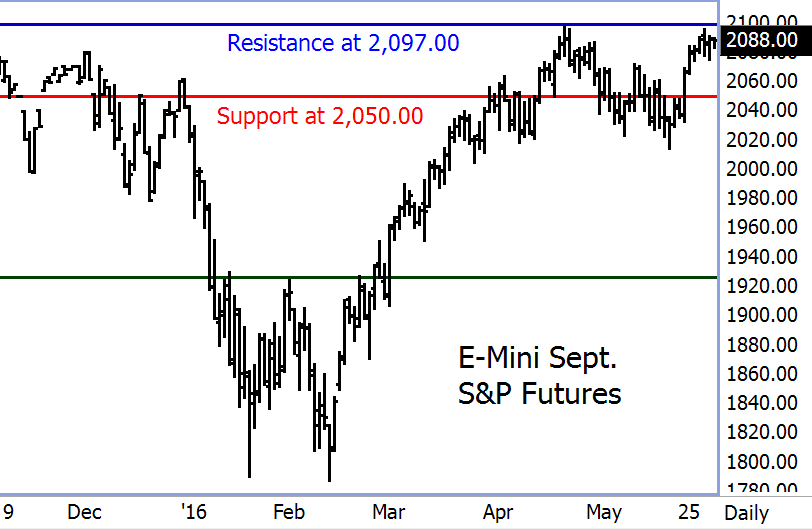June 3rd, 2016 - Issue #832

In This Issue
1. Trading 102: Seasonal Patterns in Futures
2. Hot Market: E-Mini S&Ps Pushing Up Against Resistance at Contract High
3. Economic Calendar

1. Seasonal Patterns in Futures
There are seasonal commodity trends that may reoccur within the futures market. This could help guide traders and build a plan for a futures trading strategy.The "Seasons" of the Futures Market
Every calendar year there are different seasons. It is how we plan our lives. Weather is the first to come to mind, but there are holidays, sports, shopping and many more that help break up the monotony of our day to day patterns. The commodities market is no different. Just as you use a calendar to plan and differentiate Thanksgiving from Opening Day in baseball, you can use the same calendar to blueprint possibly when wheat futures will be high and copper prices low. Traders can use these seasonal patterns to their advantage because it allows a certain degree of predictability of future price movements, rather than being bombarded by an endless stream of often contradictory market noise. Now of course there are other factors too numerous to list that can affect the futures markets, but certain conditions and events reoccur at annual intervals and help traders anticipate where the market is headed.
Although not 100% accurate-as any weatherman will tell you-weather is, in fact, the chief contributor to seasonal futures trading. The annual cycle from warm to cold weather and then back again affects all the agricultural commodity markets as their supply and demand coincides with the planting and harvesting seasons. However, the annual weather pattern can stretch its power to all the commodities. For example, demand for heating oil typically rises as cold weather approaches but subsides as inventory is filled and decreases even more as the summer months get closer. The calendar not only gives us climate related seasons, but also the annual passing of important dates that then creates 'seasons' of its own. The due date for filing U.S. income taxes is every April 15th. Monetary liquidity may decline as taxes are paid, but rise as the Federal Reserve recirculates funds.
Please fill out the form below to read the remaining article.
To Read the remaining article on "Seasonal Patterns in Futures trading", please fill out this form.
Cannon Trading respects your privacy and will never give this information to a 3rd party.2. Hot Market: E-Mini S&Ps Pushing Up Against Resistance at Contract High
From our friend Jim Wyckoff at JimWyckoff.com
Click on image below to enlarge
 The September e-mini S&P stock index futures bulls are once again knocking on the door of strong chart resistance at the contract high.
If bulls can push and close prices into new high territory, then a bullish upside "breakout" would occur to suggest a fresh leg up in prices this summer.
However, recent history has shown that the previous highs in the stock indexes have not been penetrable.
Price action the next week or so in the U.S. stock indexes could well set the tone for stock index futures trading the rest of this summer.
The September e-mini S&P stock index futures bulls are once again knocking on the door of strong chart resistance at the contract high.
If bulls can push and close prices into new high territory, then a bullish upside "breakout" would occur to suggest a fresh leg up in prices this summer.
However, recent history has shown that the previous highs in the stock indexes have not been penetrable.
Price action the next week or so in the U.S. stock indexes could well set the tone for stock index futures trading the rest of this summer.

3. Economic Calendar
Source: Moore Research Center, Inc.
| Date | Reports | Expiration & Notice Dates |
| 06/06 Mon |
FN: Jun Live Cattle(CME) |
|
| 06/07 Tues |
7:30 AM CDT - Productivity-Rev(Q1) 7:30 AM CDT - Unit Labor Costs-Rev(Q1) 2:00 PM CDT - Consumer Credit(Apr) |
|
| 06/08 Wed |
6:00 AM CDT - MBA Mortgage Purchase 9:30 AM CDT - API & DOE Energy Stats 2:00 PM CDT - Dairy Products Sales |
LT: Jul Sugar-16(ICE) |
| 06/09 Thurs |
7:30 AM CDT - USDA Weekly Export Sales 7:30 AM CDT - Initial Claims-Weekly 9:00 AM CDT - Wholesale Inventories(Apr) 9:30 AM CDT - EIA Gas Storage 3:30 PM CDT - Money Supply |
FN: Jul Sugar-16(ICE) LT: Jun Nikkei(CME) Jun Nikkei Options(CME) |
| 06/10 Fri |
9:00 AM CDT - Mich Sentiment-Prelim(Jun) 11:00 AM CDT - WASDE Report & Crop Production 1:00 PM CDT - Treasury Budget(May) |
LT: Jul Cotton Options(NYM) Jul Coffee Options(ICE) |

* Please note that the information contained in this letter is intended for clients, prospective clients, and audiences who have a basic understanding, familiarity, and interest in the futures markets.
** The material contained in this letter is of opinion only and does not guarantee any profits. These are risky markets and only risk capital should be used. Past performances are not necessarily indicative of future results.
*** This is not a solicitation of any order to buy or sell, but a current market view provided by Cannon Trading Inc. Any statement of facts herein contained are derived from sources believed to be reliable, but are not guaranteed as to accuracy, nor they purport to be complete. No responsibility is assumed with respect to any such statement or with respect to any expression of opinion herein contained. Readers are urged to exercise their own judgment in trading!






